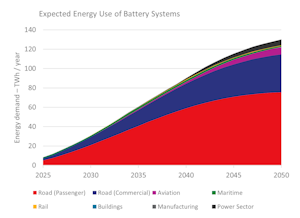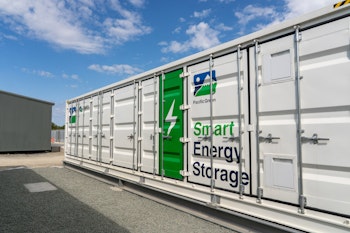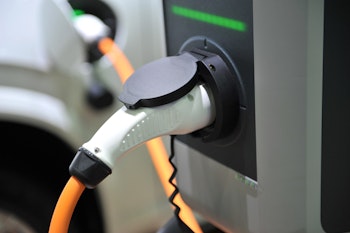Battery storage has already become a mainstay of the UK’s energy landscape. But what we have seen so far is nothing compared to what is to come. A veritable tidal wave of battery storage is on its way as the country looks to meet net zero emissions goals.
Alongside hydrogen, battery capacity in the UK is set to boom. The vast bulk of this new battery storage capacity will go into the electrification of transport, according to a report titled The Role of Hydrogen and Batteries in Delivering Net Zero in the UK by 2050.

Authored by Norway’s DNV and commissioned by the UK’s Faraday Institution , the report analyses how batteries and hydrogen can be used, between now and 2050 in UK sectors including transportation, manufacturing, the built environment and power.
“Both are anticipated to play an increasingly vital role as the UK transitions to a low-carbon future to address critical concerns of climate change and energy security,” said the Faraday Institution.
Professor Pam Thomas, chief executive officer at the Faraday Institution, said: “Batteries and hydrogen have distinct characteristics and should largely be viewed as complementary rather than competing technologies.
“Both will require significant technological advance [sic] and extensive scale up of manufacturing and deployment if the UK is to meet its obligation to reach net zero by 2050. The varying timescales of their rollout leads to considerable uncertainties in predicted market share profiles over time.”
Hari Vamadevan, executive vice president and regional director of energy systems for UK and Ireland at DNV, added: “As we strive to decarbonise and meet net zero ambitions, the energy landscape will be evolving at a faster pace, with batteries and hydrogen being key contributors.”
Despite the valuable role of batteries on the grid, 88% of UK battery capacity in 2050 will be used in road transport, with aviation and the energy sector making up most of the remaining 12%, PV Magazine has reported. [1]
The report finds that the rail and maritime industries will use battery technology sparingly, although it should be noted that the UK’s first green shipping corridor has been announced between the UK and France.
Norway’s DNV has conservatively forecast that battery energy storage systems (BESS) capacity will increase to 24 GW, with the average discharge rate increasing from one hour per day to four by 2050. An additional 45 GW of vehicle-to-grid storage will come from electric vehicles, says DNV.
It should be noted that this contrasts with April 2023 predictions from the Norwegian consultancy Rystad Energy, which forecasts 24 GW of utility-scale batteries and investments of up to $20 billion by the end of this decade.
And according to the UK’s Energy and Climate Intelligence Unit , grid-scale battery storage capacity is set to grow 14-fold, with the pipeline having increased five times from winter 2021/22 to winter 2022/23. This already exceeds National Grid’s expectations for battery storage capacity for 2035.

In terms of road transport, the advantages of batteries over hydrogen include efficient costs and a more deployable charging infrastructure, the DNV report says. The efficiency of battery systems is likely to give them an edge in power system applications too.
Grid-connected battery capacity is rapidly approaching parity with legacy pumped hydro storage in the UK. BESS accounts for about 2.1 GW of the 4.7 GW of energy storage capacity installed in the country today, with the remainder mainly coming from pumped hydro.
The UK government is looking at having 30 GW of grid-connected energy storage capacity by 2030, including batteries, flywheels, pumped hydro and liquid air systems.
The need for wider use of battery technology was underlined in a Climate Change Committee report published in June 2023, which said that surface transport remains the UK’s highest-emitting sector, contributing 23% of total UK emissions in 2022.
Vehicle electrification and green hydrogen technology must increase rapidly to meet the government’s current policy of phasing out the sale of internal combustion engines by 2030 and reaching net zero by 2050.
Because of this, and notwithstanding the trials faced by early hopefuls such as Britishvolt , battery manufacturing plants could soon be springing up across the country. Meanwhile, energy parks featuring battery storage are becoming a familiar fixture on the landscape.
There are currently hundreds of plant applications lodged with local councils across the country. One of Europe’s largest grid-scale battery storage facilities came online at Cottingham, near Hull, in 2022 and at Pacific Green we are working on an even larger project at Sheaf Energy Park .
“Large-scale battery developments will soon be the norm in the UK, solving the problem of balancing short-term power demand with the intermittency of wind and solar generation,” said Pratheeksha R, a renewable energy analyst at Rystad Energy. “And this could just be the start.
“Further growth could soon be on the way if the government introduces additional incentives to spur investments.”
Another factor driving BESS adoption could be that the presence of many more electric vehicles on the roads will drive up demand for battery systems on the grid.
Required as buffers for vehicle charging, this roll out will undoubtedly be helped by cuts in the cost of batteries as vehicle electrification scales.

Meanwhile, hydrogen technology looks set to dominate the manufacturing and industrial sectors, while remaining important in the aviation and marine industries through the production of hydrogen-derived fuels.
The DNV report says that applications are “spread across multiple sectors, with aviation, maritime and manufacturing accounting for 79% of all hydrogen use by 2050.”
The authors note that the hydrogen economy is not currently as well developed as the battery market. But it will become increasingly important from 2030, reaching an energy throughput of 105 TWh a year by 2050.
Additionally, direct use of hydrogen in manufacturing will account for 11% of energy demand by 2050, replacing coal in the steel industry and natural gas to provide heat.
The DNV report concludes that batteries will take a dominant share of the short-duration energy storage requirements, while hydrogen will be used to balance demand over a longer, seasonal periods. We will be looking to help develop both technologies at scale across the UK.
Publish date: 01 September, 2023